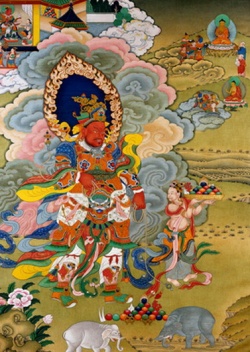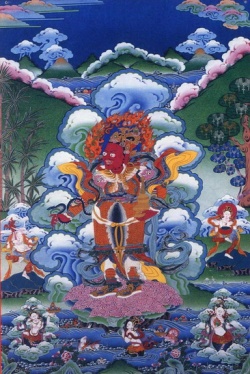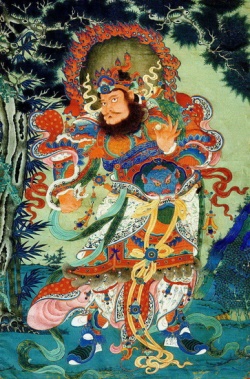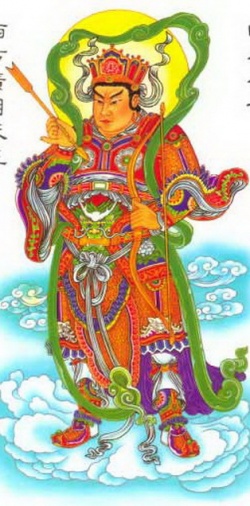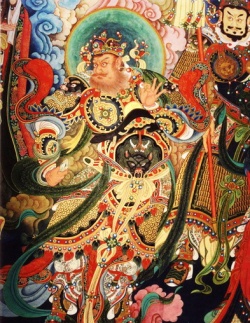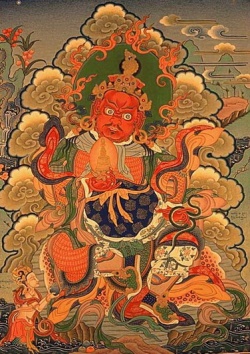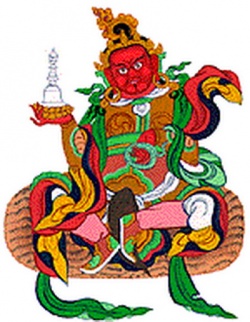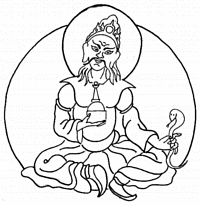Difference between revisions of "Virupaksha"
| (6 intermediate revisions by 3 users not shown) | |||
| Line 1: | Line 1: | ||
| − | [[File:Virupaksa-gmt .jpg|thumb|250px|]] | + | [[Image:VirupaksaTST.jpg|thumb|250px|'''Virupsksha''']][[File:Virupaksa-gmt .jpg|thumb|250px|]][[File:Virupaksa-gmt1.jpg|thumb|250px|]][[File:Virupaksa-gmt0.jpg|thumb|250px|]][[File:Virupaksa-gmt3.jpg|thumb|250px|]][[File:Virupaksa-gmt5.jpg|thumb|250px|]][[File:Virupaksha-king.JPG|thumb|250px|]] |
| − | + | '''[[Virupaksha]]''' (Skt. [[Virupākṣa]]; Tib. [[Chen Mi Zang]]; [[Wyl.]] ''[[spyan mi bzang]]''; Eng. 'Ugly [[Eyes]]') — one of the [[Four Great Kings]]. [[Guardian King]] of the '''[[West]]''' and leader of the [[naga]]s. | |
| − | [[Virupaksha]] | ||
| − | |||
| − | + | In a previous [[life]] he was a [[garuda]] and, along with [[Vaishravana]], had attacked two [[nagas]] who lived fearlessly on the ocean surface but were unable to harm them. The [[nagas]] explained that they had taken [[refuge]] in [[Buddha]] [[Kashyapa]] and their [[virtue]] protected them. Hearing this the two [[garudas]] also took [[refuge]]. The two [[nagas]] and two [[garudas]] all prayed to be [[reborn]] in the [[time]] of [[Buddha Shakyamuni]] in order to support him. | |
| − | [[ | + | He protects [[beings]] in the {{Wiki|western}} [[direction]], averting forces that obstruct the practice of [[Dharma]]. His glance is harmful to [[beings]] and so he avoids looking at them by gazing at the [[stupa]] he carries. |
| − | + | ==Further Reading== | |
| − | + | {{Nolinking|*''Crystal Mirror, volume VI'', Dharma Publishing 1984}} | |
| − | |||
| − | + | {{RigpaWiki}} | |
| − | + | {{NewSourceBreak}} | |
| − | + | [[Virupaksha]] ~ [[Virūpākṣa]] <br/> | |
| − | [[Virupaksha]] | + | ([[Japanese]]: [[広目天]] [[Kōmoku-ten]]) |
| − | + | The [[heavenly king]] Wide-Eyed. One of the [[four heavenly kings]]. | |
| + | {{R}} | ||
| + | [http://www.sgilibrary.org/search_dict.php?id=2609 sgilibrary.org] | ||
| + | {{NewSourceBreak}} | ||
| + | Wide-Eyed<br/> | ||
| + | [[広目天]] (Skt [[Virupaksha]]; Jpn [[Komoku-ten]]) | ||
| − | [[ | + | One of the [[four heavenly kings]] of [[Buddhist mythology]]. This [[god]] is said to live halfway up the {{Wiki|western}} side of [[Mount Sumeru]] and {{Wiki|protect}} the {{Wiki|western}} quarter. With his [[divine]] eyesight, he discerns [[evil]], punishes evildoers, and [[causes]] them to aspire for [[Buddhahood]]. Wide-Eyed is also known as the [[lord]] of [[naga]] ([[dragons]]) and [[spirits]] called [[putana]]. Though the [[Sanskrit]] [[name]] [[Virupaksha]] was rendered in {{Wiki|Chinese}} as "wide-eyed," it more literally means irregular-, abnormal-, or many-eyed. In [[Hindu]] [[mythology]], [[Virupaksha]] is an [[epithet]] for the three-eyed [[god]], [[Shiva]]. |
| − | [ | + | {{R}} |
| + | [http://www.sgilibrary.org/search_dict.php?id=2634 sgilibrary.org] | ||
| + | {{NewSourceBreak}} | ||
| + | [[Dai Komoku Tenno]] <br/> [[Virupaksha]] ~ [[Heavenly King of the West]] | ||
| − | + | [[Virupaksha]] is one of the [[four heavenly kings]]. The Flammarion Iconographic [[Guide]]: [[Buddhism]] describes [[Virupaksha]] as follows: | |
| − | + | : "This is the [[guardian king of the west]], '[[He who observes everything that happens in the kingdom]]', '[[He who sees all]]'; he presides over the autumn." (p.247) | |
| − | |||
| − | |||
| − | + | [[Virupaksha]]'s {{Wiki|army}} and {{Wiki|attendants}} are composed of the [[nagas]] and [[putanas]]. The [[nagas]] are the [[dragons]] or {{Wiki|serpents}} who dwell beneath the ocean and who control the tides, the flow of the [[rivers]], and the [[rain]]. The [[nagas]] are one of the eight kinds of {{Wiki|supernatural}} {{Wiki|beings}} who are said to revere and {{Wiki|protect}} the {{Wiki|Dharma}}. The [[putanas]] are another type of [[hungry ghost]] who are associated with fevers but also with the [[protection]] of {{Wiki|pregnant}} women. | |
| − | + | Icon: A helmeted [[warrior]] wearing armor and wind-blown scarves. He has a yellow complexion and a [[wrathful]] expression. He holds a {{Wiki|trident}} in his right hand and his closed left hand rests on his hip. | |
| − | + | {{R}} | |
| + | [http://nichirenscoffeehouse.net/ShuteiMandala/4kings.html nichirenscoffeehouse.net] | ||
| + | {{NewSourceBreak}} | ||
| + | [[Virūpākṣa]] ([[Japanese]]: [[広目天]] [[Kōmoku-ten]]) is one of the [[Four Heavenly Kings]] representing the [[cardinal direction]] of the [[west]] in [[Buddhist cosmology]]. | ||
| − | [[ | + | His followers are the [[Nāga]]. His [[name]] means 'He who sees all'. |
| + | {{W}} | ||
| + | {{NewSourceBreak}} | ||
| + | The [[king]] of the [[Nagas]] is [[Virupaksha]], one of the four [[Lokapala]], or [[Celestial]] Guardians of the Four [[Cardinal Points]]. His {{Wiki|kingdom}} is the continent [[west]] of [[Mount Meru]] but the chief residence of the [[Nagas]] is {{Wiki|Bhogavati}}, 3,000 yoganas under the sea. | ||
| − | + | {{R}} | |
| + | [http://www.wisdomlib.org/definition/virupaksha/index.html wisdomlib.org] | ||
| + | {{NewSourceBreak}} | ||
| + | [[Virupaksha]] is one of the [[four great kings]] who rules the first [[heaven]] of [[desire realm]] in the [[west]]. [[Virupaksha]] serves as the {{Wiki|guardian}} of this [[Jambudvipa]] of the {{Wiki|western}} [[direction]]. | ||
| − | '''oṃ virūpākṣa nāgādhipataye svāhā | + | His [[body]] is red in {{Wiki|colour}}. [[Virupaksha]] shows a [[wrathful]] [[appearance]]. His right hand holds a {{Wiki|spear}} of three points, his left fist rests on his knee. [[Virupaksha]] can be [[recognized]] through the [[Chaitya]] {{Wiki|symbol}} in his left hand. |
| + | |||
| + | [[Virupaksha]] [[lives]] in the city of [[Sudarsana]] on the [[west]] of [[Sumeru]] Mountain. His city is as beautiful as that of the three other [[kings]]. [[Virupaksha]] leads [[immeasurable]] {{Wiki|serpent}} [[deities]] i.e. [[Nagas]] to {{Wiki|protect}} [[Buddha]] [[dharma]] in the [[west]]. | ||
| + | |||
| + | [[Virupaksha]] leads besides the retinue of [[Nagas]], innumerable [[spirits]] of {{Wiki|sun}} and {{Wiki|moon}} and others. They are all responsible for the {{Wiki|protection}} of the [[Buddha]] [[dharma]]. {{Wiki|Devotees}} {{Wiki|worship}} these four [[maharajas]] in a group. | ||
| + | |||
| + | {{R}} | ||
| + | [http://www.shakyastatues.com/statue/fourgreatkingsvirupaksha shakyastatues.com] | ||
| + | {{NewSourceBreak}} | ||
| + | ([[Tibetan]]: [[chen mi zang]]): {{Wiki|Guardian}} of the {{Wiki|Western}} [[Direction]] and [[King]] of the [[Nagas]]. | ||
| + | |||
| + | With one face and large round [[eyes]], a brown moustache and beard, the right hand holds at the waist a writhing {{Wiki|snake}} {{Wikidictionary|entwined}} around the upper arm - grey in {{Wiki|colour}} with a white belly. With the left hand upraised, he holds a single white pearl-like drop with a lick of yellow flame extending upward from the center. Adorned with an ornate {{Wiki|crown}} of {{Wiki|gold}}, [[jewels]] and a small red ribbon at each side he is richly garbed in the raiment of a [[king]], opulent with {{Wiki|silk}} brocades and elaborate designs in varieties of {{Wiki|colour}}. | ||
| + | |||
| + | {{R}} | ||
| + | [http://www.thangkar.com/art/show/show/4gua/fgua-en.htm thangkar.com] | ||
| + | {{NewSourceBreak}} | ||
| + | [[Virupaksha]] ([[Tibetan]]: [[chen mi zang]]): Guardian of the {{Wiki|Western}} [[Direction]] and [[King]] of the [[Nagas]]. | ||
| + | |||
| + | "Well protecting the [[Buddha's Teachings]] with heroic strength of arms; homage to the [[Kings]] of the Four [[Directions]], [[North]], [[South]], [[East]] and [[West]]." ([[Sakya]] liturgical verse). | ||
| + | |||
| + | From the set of the [[Four Guardian Kings]] of the [[Directions]] the other three are [[Vaishravana]] - the leader, [[Virudhaka]] and [[Dhritarashtra]]. [[Traditionally]] painted in association with the [[Buddha]] and [[16 Great Arhats]] the full group would comprise a total of 25 figures: the [[buddha]] [[Shakyamuni]] together with the two foremost [[disciples]] - [[Shariputra]] and [[Maudgalyayana]], the [[16 Arhats]], the attendant [[Dharmata]] and the {{Wiki|patron}} [[Hvashang]], together with the [[Four Kings]] | ||
| + | |||
| + | {{R}} | ||
| + | [http://www.himalayanart.org/search/set.cfm?setID=566 himalayanart.org] | ||
| + | {{NewSourceBreak}} | ||
| + | [[Gwangmok Cheonwang]] ([[Virupaksha]] he holds a [[dragon]] in one hand and a [[jewel]] in the other. Unfortunately, the meaning of these [[symbols]] has been lost to [[time]]. | ||
| + | {{R}} | ||
| + | [http://www.koreabridge.net/post/cheonwangmun-four-heavenly-kings-korean-temple-gates-dostoevsky2181?page=6 koreabridge.net] | ||
| + | {{NewSourceBreak}} | ||
| + | |||
| + | Translated as "[[Great Heavenly King Wide-Eyed]]," [[Dai Komoku-tenno]] is one of the [[Four Heavenly Kings]]. He [[lives]] halfway down the {{Wiki|western}} side of [[Mount Sumeru]] and protects the [[western continent]]. With his [[divine]] eyesight, he is said to discern good from [[evil]], punish those who do [[evil]] [[deeds]], and to arouse the [[aspiration]] for [[attaining]] [[Buddhahood]]. | ||
| + | |||
| + | Everything in the [[world]] is constantly changing. [[Dai Komoku-tenno]] [[symbolizes]] being flexible and [[wise]] enough to deal with [[life]]. His special eyesight enables him to accurately {{Wiki|perceive}} the [[nature]] of the [[world]] and thus make [[wise]] decisions. | ||
| + | |||
| + | Attendants are composed of the [[nagas]] and [[putanas]]. The [[nagas]] are the [[dragons]] or serpents who dwell beneath the ocean and who control the tides, the flow of the [[rivers]], and the [[rain]]. They are one of the eight kinds of [[supernatural]] [[beings]] who are said to revere and {{Wiki|protect}} the [[Dharma]]. The [[putanas]] are another type of [[hungry ghost]] who are associated with fevers and also with the [[protection]] of {{Wiki|pregnant}} women. | ||
| + | |||
| + | [[Appearance]]: [[Dai Komoku-tenno]] has red {{Wiki|skin}}; he is dignified and richly ornamented with [[precious]] [[gems]]. In his right hand, he holds a [[jewel]], and in his left hand, a {{Wiki|snake}}. His glare is deadly, for his penetrating [[eyes]] are also {{Wiki|poisonous}}, so [[Dai Komoku-tenno]] stares unflinchingly at the [[jewel]] in his hand to avoid {{Wiki|killing}} [[beings]]. | ||
| + | |||
| + | {{R}} | ||
| + | [http://www.gakkaionline.net/mandala/Komoku.html gakkaionline.net] | ||
| + | {{NewSourceBreak}} | ||
| + | [[File:Virupaksa.png|frameless|left|250px|]] | ||
| + | |||
| + | [[King]] of the [[West]]. Red in {{Wiki|colour}}; holding a [[stūpa]], and {{Wiki|snake}} (or [[nāga]]). [[King]] of the [[Nāgas]]. His names means something like "all [[seeing]]". | ||
| + | |||
| + | Virūpākṣa's association with serpents and [[water]] suggests a connection with the {{Wiki|Vedic}} [[god]] {{Wiki|Varuṇa}}. Initially a {{Wiki|solar}} [[god]], often paired with [[mitra]], {{Wiki|Varuṇa}} was the guardian of [[ṛta]] - the [[cosmic]] order. Later, in the [[Hindu]] Epics, he was relegated to being a [[protector]] of [[water]] and was associated with [[water spirits]], such as [[nāgas]]. Some [[scholars]] point to similarities with the {{Wiki|Greek}} {{Wiki|Titan}} {{Wiki|Uranus}} (the names are {{Wiki|phonetically}} similar). <br/> | ||
| + | |||
| + | [[File:Virupaksamantra.png|frameless|450px|]]<br/> | ||
| + | |||
| + | '''[[oṃ]] vi rū pā kṣa nā gā dhi pa ta ye svā hā | ||
| + | |||
| + | '''[[oṃ]] [[virūpākṣa nāgādhipataye]] [[svāhā]] | ||
| + | |||
| + | "[[virūpākṣa nāgādhipataye]]" can be translated as [[Virūpākṣa Lord of the Nāgas]]. | ||
| + | |||
| + | "[[Nāga]]" in [[Pāli]] and {{Wiki|modern}} [[Indian]] [[languages]] means [[elephant]], and is also sometimes applied to any large [[animal]] such as a [[bull]]. The [[Buddha]] is refered to a a great [[Nāga]]. | ||
| + | |||
| + | {{R}} | ||
| + | [http://www.visiblemantra.org/kings.html visiblemantra.org] | ||
| − | |||
| − | |||
| − | |||
[[Category:Virupaksha]] | [[Category:Virupaksha]] | ||
Latest revision as of 11:45, 8 July 2014
Virupaksha (Skt. Virupākṣa; Tib. Chen Mi Zang; Wyl. spyan mi bzang; Eng. 'Ugly Eyes') — one of the Four Great Kings. Guardian King of the West and leader of the nagas.
In a previous life he was a garuda and, along with Vaishravana, had attacked two nagas who lived fearlessly on the ocean surface but were unable to harm them. The nagas explained that they had taken refuge in Buddha Kashyapa and their virtue protected them. Hearing this the two garudas also took refuge. The two nagas and two garudas all prayed to be reborn in the time of Buddha Shakyamuni in order to support him.
He protects beings in the western direction, averting forces that obstruct the practice of Dharma. His glance is harmful to beings and so he avoids looking at them by gazing at the stupa he carries.
Further Reading
- Crystal Mirror, volume VI, Dharma Publishing 1984
Source
Virupaksha ~ Virūpākṣa
(Japanese: 広目天 Kōmoku-ten)
The heavenly king Wide-Eyed. One of the four heavenly kings.
Source
Wide-Eyed
広目天 (Skt Virupaksha; Jpn Komoku-ten)
One of the four heavenly kings of Buddhist mythology. This god is said to live halfway up the western side of Mount Sumeru and protect the western quarter. With his divine eyesight, he discerns evil, punishes evildoers, and causes them to aspire for Buddhahood. Wide-Eyed is also known as the lord of naga (dragons) and spirits called putana. Though the Sanskrit name Virupaksha was rendered in Chinese as "wide-eyed," it more literally means irregular-, abnormal-, or many-eyed. In Hindu mythology, Virupaksha is an epithet for the three-eyed god, Shiva.
Source
Dai Komoku Tenno
Virupaksha ~ Heavenly King of the West
Virupaksha is one of the four heavenly kings. The Flammarion Iconographic Guide: Buddhism describes Virupaksha as follows:
- "This is the guardian king of the west, 'He who observes everything that happens in the kingdom', 'He who sees all'; he presides over the autumn." (p.247)
Virupaksha's army and attendants are composed of the nagas and putanas. The nagas are the dragons or serpents who dwell beneath the ocean and who control the tides, the flow of the rivers, and the rain. The nagas are one of the eight kinds of supernatural beings who are said to revere and protect the Dharma. The putanas are another type of hungry ghost who are associated with fevers but also with the protection of pregnant women.
Icon: A helmeted warrior wearing armor and wind-blown scarves. He has a yellow complexion and a wrathful expression. He holds a trident in his right hand and his closed left hand rests on his hip.
Source
Virūpākṣa (Japanese: 広目天 Kōmoku-ten) is one of the Four Heavenly Kings representing the cardinal direction of the west in Buddhist cosmology.
His followers are the Nāga. His name means 'He who sees all'.
Source
The king of the Nagas is Virupaksha, one of the four Lokapala, or Celestial Guardians of the Four Cardinal Points. His kingdom is the continent west of Mount Meru but the chief residence of the Nagas is Bhogavati, 3,000 yoganas under the sea.
Source
Virupaksha is one of the four great kings who rules the first heaven of desire realm in the west. Virupaksha serves as the guardian of this Jambudvipa of the western direction.
His body is red in colour. Virupaksha shows a wrathful appearance. His right hand holds a spear of three points, his left fist rests on his knee. Virupaksha can be recognized through the Chaitya symbol in his left hand.
Virupaksha lives in the city of Sudarsana on the west of Sumeru Mountain. His city is as beautiful as that of the three other kings. Virupaksha leads immeasurable serpent deities i.e. Nagas to protect Buddha dharma in the west.
Virupaksha leads besides the retinue of Nagas, innumerable spirits of sun and moon and others. They are all responsible for the protection of the Buddha dharma. Devotees worship these four maharajas in a group.
Source
(Tibetan: chen mi zang): Guardian of the Western Direction and King of the Nagas.
With one face and large round eyes, a brown moustache and beard, the right hand holds at the waist a writhing snake entwined around the upper arm - grey in colour with a white belly. With the left hand upraised, he holds a single white pearl-like drop with a lick of yellow flame extending upward from the center. Adorned with an ornate crown of gold, jewels and a small red ribbon at each side he is richly garbed in the raiment of a king, opulent with silk brocades and elaborate designs in varieties of colour.
Source
Virupaksha (Tibetan: chen mi zang): Guardian of the Western Direction and King of the Nagas.
"Well protecting the Buddha's Teachings with heroic strength of arms; homage to the Kings of the Four Directions, North, South, East and West." (Sakya liturgical verse).
From the set of the Four Guardian Kings of the Directions the other three are Vaishravana - the leader, Virudhaka and Dhritarashtra. Traditionally painted in association with the Buddha and 16 Great Arhats the full group would comprise a total of 25 figures: the buddha Shakyamuni together with the two foremost disciples - Shariputra and Maudgalyayana, the 16 Arhats, the attendant Dharmata and the patron Hvashang, together with the Four Kings
Source
Gwangmok Cheonwang (Virupaksha he holds a dragon in one hand and a jewel in the other. Unfortunately, the meaning of these symbols has been lost to time.
Source
Translated as "Great Heavenly King Wide-Eyed," Dai Komoku-tenno is one of the Four Heavenly Kings. He lives halfway down the western side of Mount Sumeru and protects the western continent. With his divine eyesight, he is said to discern good from evil, punish those who do evil deeds, and to arouse the aspiration for attaining Buddhahood.
Everything in the world is constantly changing. Dai Komoku-tenno symbolizes being flexible and wise enough to deal with life. His special eyesight enables him to accurately perceive the nature of the world and thus make wise decisions.
Attendants are composed of the nagas and putanas. The nagas are the dragons or serpents who dwell beneath the ocean and who control the tides, the flow of the rivers, and the rain. They are one of the eight kinds of supernatural beings who are said to revere and protect the Dharma. The putanas are another type of hungry ghost who are associated with fevers and also with the protection of pregnant women.
Appearance: Dai Komoku-tenno has red skin; he is dignified and richly ornamented with precious gems. In his right hand, he holds a jewel, and in his left hand, a snake. His glare is deadly, for his penetrating eyes are also poisonous, so Dai Komoku-tenno stares unflinchingly at the jewel in his hand to avoid killing beings.
Source
King of the West. Red in colour; holding a stūpa, and snake (or nāga). King of the Nāgas. His names means something like "all seeing".
Virūpākṣa's association with serpents and water suggests a connection with the Vedic god Varuṇa. Initially a solar god, often paired with mitra, Varuṇa was the guardian of ṛta - the cosmic order. Later, in the Hindu Epics, he was relegated to being a protector of water and was associated with water spirits, such as nāgas. Some scholars point to similarities with the Greek Titan Uranus (the names are phonetically similar).
oṃ vi rū pā kṣa nā gā dhi pa ta ye svā hā
oṃ virūpākṣa nāgādhipataye svāhā
"virūpākṣa nāgādhipataye" can be translated as Virūpākṣa Lord of the Nāgas.
"Nāga" in Pāli and modern Indian languages means elephant, and is also sometimes applied to any large animal such as a bull. The Buddha is refered to a a great Nāga.
